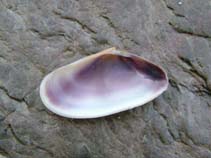Donax vittatus (da Costa, 1778)
Banded-wedge shell| Native range | All suitable habitat | Point map | Year 2050 |

|
| This map was computer-generated and has not yet been reviewed. |
| Donax vittatus AquaMaps Data sources: GBIF OBIS |
Classification / Names Populärnamn | synonymer | CoL | ITIS | WoRMS
Bivalvia | Cardiida | Donacidae
Environment: milieu / climate zone / djupintervall / distribution range Ekologi
; brackvatten; djupintervall 0 - 20 m (Ref. 105964). Subtropical; 72°N - 16°N, 29°W - 37°E
Distribution Länder | FAO områden | Ekosystem | Förekomster | Utplanteringar
Eastern Atlantic and the Mediterranean.
Length at first maturity / Size / Weight / Age
Könsmognad: Lm ? range ? - ? cm Max length : 4.0 cm SHL hane/ej könsbestämd; (Ref. 7882)
Life cycle and mating behavior Könsmognad | Reproduktion | Lek | Eggs | Fecundity | Larvae
Main reference
referenser | Koordinator | Medarbetare
Alves, F., L. Chicharo, A. Nogueira and J. Regala 2003 Changes in benthic community structure due to clam dreging on the Algarve coast and the importance of seasonal analysis. J. Mar. Biol. Ass. U.K. 83:719-729. (Ref. 2851)
IUCN Red List Status
(Ref. 130435: Version 2025-1)
CITES status (Ref. 108899)
CMS (Ref. 116361)
Threat to humans
Human uses
| FishSource |
Verktyg
Ytterligare information
Max. ages / sizes
Length-weight rel.
Length-length rel.
Length-frequencies
Mass conversion
Abundans
Internet-källor
BHL | BOLD Systems | CISTI | DiscoverLife | FAO(Publication : search) | Fishipedia | GenBank (genome, nucleotide) | GloBI | Gomexsi | Google Books | Google Scholar | Google | PubMed | Tree of Life | Wikipedia (Go, sök) | Zoological Record



